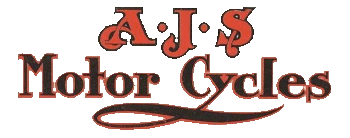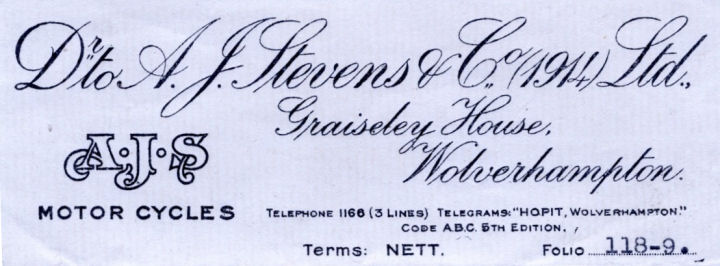


1897 Inspired by a Mitchel engine of poor performance, sons Harry and Joe had built an engine which outperformed the American unit.
1899 The Stevens Motor Manufacturing Co of Wolverhampton, was established in 1899.
Albert John Stevens built his first internal combustion engine in 1897, although did not go into commercial production until after 1900.
1909 The company was founded by the Stevens brothers, although the family was involved with the production of motorcycles before the turn of the century. The first engines, 125cc, were used by other companies. In 1905, Stevens built a bike with a JAP V-twin, with leading-link front forks and a swinging fork at rear. They had also been producing frames.
1910 The first model was produced as a 292cc (2.5hp) single with either a direct belt drive or a two-speed with chain drive.
1913 The V-twin model was a best-seller for sidecar use. The sidecars were produced by the Hayward firm. In the Junior TT of that year, AJS machines took 1st, 2nd, 4th and 6th places, and there was soon a boost in demand.
The Great War saw the production of munitions, but they continued to make motorcycles.
1914 Directory lists them as Stevens, A. J., and Co., Retreat Street, Wolverhampton and as motor cycle manufacturers.
1915 The range consisted of three models; the sporty 2.75hp single, a medium weight 4hp (550cc) twin and, as top of the range, the 6hp model D with Brampton patent spring forks, three speed counter-shaft gearbox and internal expanding rear brake. A new feature on all 1915 models was the so called AJS 'scientific frame' with straight top tube sloping from head to seat lug, eliminating the use of bent tubes.
1919 The V-twin engine was greatly altered although the gearbox remained unchanged. At the Olympia show a new 6hp model was introduced. Its features included a new type of saddle tank, interchangeable and quickly detachable wheels, specially sprung comfortable saddle, foot-boards with rubber mats, rear stand operated by hand lever and big size aluminium exhaust damper, placed under the front of the engine. Engine capacity was 748cc, bore and stroke 74mmx87mm. It had detachable cylinder-heads, high-tension magneto ignition and a three speed gearbox and was also available in combination form.
1920 AJS took over the Hayward company, and returned to the TT. The company introduced several innovations, including internal expanding brakes and all-chain drive.
1921 Design improvements and revised engines brought many sporting successes. Most remarkable of those were at the Island TT where they took an impressive 1st, 2nd, 3rd, 4th and 6th followed by a resounding win (by a two minute lead) in the Senior TT, two days later.
1922
1927 AJS won a contract to produce the Clyno Nine car and they diversified further and somewhat unsuccessfully into commercial vehicles and even radios. For the motorcycles they brought in an overhead, chain-drive camshaft.
1928 The company had problems with trading conditions, Clyno failed and the contract ended. AJS then went into the production of commercial vehicle chassis and added the AJS Nine car to their product line. Motorcycle models for 1928 went from K1 to K12 with SV, OHV and OHC engines of 248cc to 799cc.
1929 The whole range was redesigned, most notably with the use of the saddle tank and separate oil tank.
1930 A 350cc machine won the Lightweight TT. The firm now held over 100 world records.
1931 They built the S3, an ambitious 496cc transverse tourer with alloy cylinder heads and other advanced design elements and even though times were hard the company still increased their product range. During that year they were engulfed by financial problems. In October 1931 AJS was wound up, creditors paid in full and rights sold to Matchless. (Although the new owners moved the firm to Plumstead and restricted the range produced, it was not the end of Stevens or the AJS name). Production continued using the Matchless engine.
AJS had been producing Graiseley sidecars. This part of the business was sold to Diamond for £475.
1934-1938 The Stevens brothers went on to start again under the Stevens name.
1940 Production turned to war work and AMC concentrated on Matchless, with few AJS machines being built. Those models produced were shared, but using different badging.
Following World War II, the AMC concern built AJS and Matchless motorcycles at Plumstead following the same format.
1946 A small batch of competition models was produced, with minimal design changes. AJS was actively involved in both on- and off-road racing.
1949 The range of road vehicles was increased, along with various competition models and this set the trend until 1952.
1953 to 1962 saw the introduction of many new models and a variety of design changes, with success both on and off the race-track.
1963 The range was pared down; and again in 1964.
1966 This was the last year of production in their old format as AMC was in financial trouble. When AMC failed that year, the marque was bought by Manganese Bronze Holdings, who formed the Norton Villiers group.
1967 The AJS 33, model CSR, was produced under new ownership until 1967. Certain Matchless models were built until 1969.
1969 Production ceased and the factory was demolished, but both names survived.
AJS Two-Strokes were motorcycles produced from 1967 to 1973. They have been produced again since 1987.
1967 The name was revived by Norton Villiers, who produced a couple of two-stroke competition machines.
1973 These bikes were no longer offered in kit form - as had been the case in the past. The company was sold to Fluff Brown who created the FB-AJS range, which later reverted to the original name of AJS.
1974-1981 FB-AJS models were built in the image of the older AJS machines. The firm continued to thrive on the back of the nostalgia boom.
1991 onwards. Replicas of the early-1960s Cotton models were produced.
Note: AJS and Matchless have an owners' club web site, listed here
If you have a query or information about AJS please contact us